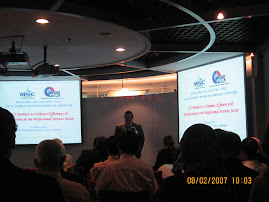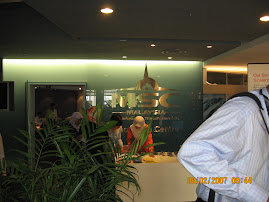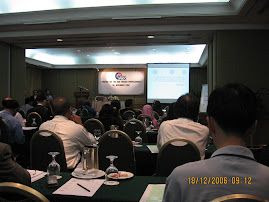(Continuing from Part 6...). This is a dispute in which:
- P alleges that there was a co-agency or co-broking agreement in a written document dated on or around 4.1.2005 (Exhibit P15) involving 2 parcels of lands for sale by tender (Paras 3 & 2.2 of P's Statement of Claim and A15 of P's Witness Statement) BUT D had adduced evidence:
- that on or around 4.1.2005, the 2 parcels of lands were not known or available by D for sale by tender yet (Exhibit P-41 at Page 12 Bundle E, etc);
- that many elements for the formation of a valid contract are absent in Exhibit P-15, namely:
- no valid acceptance of D's counter proposal;
- signatory for P's firm is not competent under Sec 11 of the Contracts Act to contract for P or P's firm because Sharon DM is not a name in the register of estate agents of the Lembaga and is as such expressly disqualified by Rule 102(3) of the VAEA Rules to represent any estate agent or firm in any professional estate agency documents including co-agency agreement on fees (see also Circular 2/97);
- Exhibit P15 has on its face the unlawful object of P's firm attempting to collect fee from party other than its client thereby contravening Rule 89 of the VAEA Rules 1986 - rendering Exhibit P15 void as a contract under Sec 24 of the Contracts Act 1950;
- the heading and wordings of Exhibit P15 are so vague and ambiguous that there is clearly no 'consensus ad idem' or mutual consent on the property referred to and on the terms of the alleged agreement;
- the presence of Exhibit P16 meant that Exhibit P15 need not be performed by either party under Sec 63 of the Contracts Act.
- P alleges that on or around 16.2.2005, P has successfully introduced a buyer Y to the defendant D to buy the 2 parcels of lands (Para 4 of P's Statement of Claim) BUT undeniable evidence before the Court, among others, is:
- that P has never met nor spoken with D;
- P's operative M has merely spoken with D but has never informed D about Y the bidder for the 2 parcels of lands; M has never met with D; before the tender closed, M never informed D that Gary was her husband which resulted in D never asked P's firm to pay for the tender packages which were given to Gary FOC because Gary also did not at any time before the tender closed revealed that he was the husband of M;
- M had on her own without D's knowledge and consent showed the 2 parcels of lands to Y;
- Y had never met D also;
- P's firm has never bought nor paid for nor share with D's firm the costs of any tender packages for the 2 parcels of lands;
- no one from P's firm has ever obtained any tender submission from any party including Y for D firm's acknowledgment and submission;
- Std 3.2.8 co-agency inspection with D knowledge and overall supervision never took place...;
- when D informed M in mid-2005 that he had received the fees and service tax and would like to meet up with P, P did not come out to identify herself in anyway including as also known as Sharon DM the signatory for P's firms all along;
- it was only in July 2006 - apparently after all private caveats on the 2 parcels of lands had been removed with the fees and service tax no longer facing any risks of being recalled by D's client - that P appeared for the first time using her official name P, her designation Principal and her signature to stake 50% claim on D's fees;
- likelihood of impersonation before P appeared, risks of service tax and fees recall before private caveats were finally removed from the 2 lands, etc. - are real and legitimate issues existing during the material times but were only non-issues after P appeared and the private caveats were removed. (P's lawyer who was very prolix in his submission kept harping on the facts that impersonation and fulfillment of conditions-precedent are no longer issues, therefore D must pay - in other words, when there were risks, D is to shoulder all the risks (and costs too) and P avoid and evade them by hiding under the unofficial name Sharon DM BUT when all the risks disappeared, P appeared under her official name and claimed 50% of D's fees - head she wins, tail, D loses!)
4. Prior to P's suit, P had never forwarded any valid demands for co-agency fee even if there was a valid co-agency agreement which D denies there was because the 1st Letter of Demand (LOD) from P's firm relied on an Invoice (No.00058) which has blatant illegalities on its face and the 2nd LOD was also invalid because that letter from P's lawyer in Nov. 2006 claims to act for P's firm which clearly no longer existed since 29.8.2006.
5. P alleges that D was not straight forward. But D felt that P was the one using and abusing the legal process to make all kinds of unprintable and unsubstantiated scurrilous attacks and character assassination on D -- aiming to destroy D's credibility BUT overwhelming evidence before the Court is:
- that P's lawyer CWC attempted to suppress D's material evidence that D was dealing only with Gary and never with any one from P's firm in respect of the tender submission by Y the bidder: Pgs 2 ~ 7 of Bundle D were material evidence forwarded by D's lawyer to P's lawyer for filing way back in early 2008. The top part of every page of this 6-pg document show that they were all forwarded by Gary to D and not by P's firm and that the entire document (including Gary's cover note) do not mention any thing about P, M, P's firm or anyone from P's firm. But what was bundled and filed by P's lawyer CWC in pgs 27 ~ 31 of Bundle C on 14 Jan 2009 were different - only 1 page of D's document was included (pg. 2 of Bundle D) - the rest were replaced with documents of unknown origin which are capable of misleading the judge as the top parts of these pages (of unknown origin) suggest that they came from P's firm. It took D's lawyers many phone calls, at least 4 letters (12.10.09, 13.1.2010, 18.3.2010, 17.5.2010) and D telling D's lawyer that D would complain to the judge about the matter that P's lawyer CWC only filed the entire correct documents as pgs. 2 ~ 7 of Bundle D on 4.6.2010 (Fri) - just 1 working day before the trial began on 7.6.2010 (Mon). D tried to highlight this to the judge when he took to the witness stand in 2011 but was interrupted half-way by his own lawyer - so much about loyalty and absolute fidelity of a professional to his client. Both lawyers were still socialising with each other as they 'fought' the case...
- that the plaintiff P had not been straight in her estate agency practice because she practised by not using her registered official name but under the cover of an unofficial name Sharon DM (which was at no time stated to be also P), a lower designation (Resident Manager) and a consistently different signature;
- that P also attempted to adduce a false document (Exhibit P26 at Page14 Bundle F) to deceive the judge that P's firm had registered M as its negotiator when that document clearly shows it was another firm which did so in the year 2010!;
- P feigned inability to read figures when P is a real estate agent who constantly deal with figures. This happened after P discovered 4 frivolous errors in P's figures of claims in the Summons and Statement of Claims and applied for D's consent to have them corrected on grounds of typo error. D magnanimously agreed to the amendments but whose kindness was repaid with hurtful scurrilous attacks and character-assassination by P's lawyer who was grabbing at any straw;
- P demonstrated practically zero knowledge of what was happening in the alleged transaction before the Court - P categorically states in her Jawapan ('Statement of Reply') that she had no knowledge of Gary's involvement in the alleged transaction, yet M testified under oath that M directed Gary her husband Gary to be involved in the transaction, So who is the boss here - P or M? P being the REA should be the one directing and supervising M the non-REA, yet M was practising as she likes without P's knowledge nor close supervision or direction: Wasn't this the hallmark of "licence-leasing"?
- RM2000 on 27.5.07 (paid via EBB Cheque #006887) as deposit;
- RM4763.40 on 2.2.09 (paid viaEBB #000087) as fees; plus,
- RM6033.40 (deposit included) on 1.4.2011.
When lawyers postpone your case due to them having too many cases to attend to on the same day, why is it that you have to pay for their postponements - attendance fees, meals, etc. - to allow them to earn more from the other cases. And during the series of postponement, your life hung in the air - nothing much can be achieved - your incomes suffer, your life got affected! If the postponements were requested by the client (say, sickness, travel, etc.), charging the client would be fair but not so when the postponements were to allow the lawyers to attend to other cases.
Another thing about court trial D discovered is this: With this KPI (Key Performance Index) thing going on, the judge may allow only 1 side to read their witness statements in the open court and the other side not allowed to do so at all. In this case, P and her 3 witnesses got to read their Witness Statements and made corrections when they spotted errors on them whereas D did not get the chance to do so as that would mean another day of open trial....
D would have preferred the same right to do so as the copies of Witness Statements he was asked to sign in the Witness Stand, only a copy of which was given to him to go through in the same morning of the final day of trial. Ideally, all copies that he has to sign have to be given to him to go through first to ensure that they are all identical and none has any errors on them. This procedural weakness must be tightened to ensure that it leaves no rooms for exploitation by rogue lawyers and the corrupted...A legal case should be decided strictly on truth, justice and the rule of law and NEVER on public relations - which side has more people or witnesses and speedy perception of story from only 1 side!
The outcome of this case?...You'd know in due course...OMG...that's probably the end! What a life!





